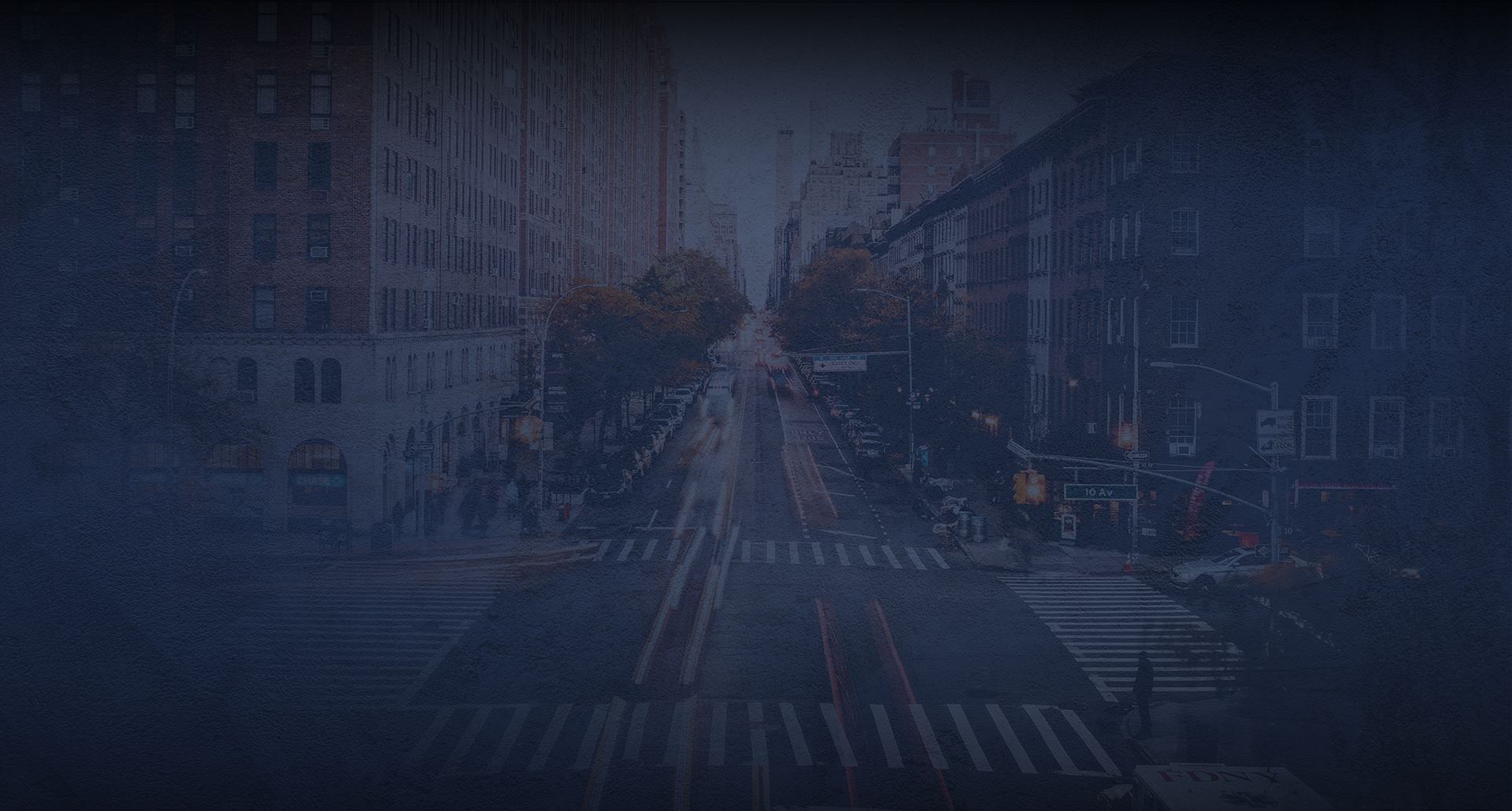

New York Personal Injury Attorney
Holding Negligent Parties Accountable for Your Injuries
With decades of legal experience, we have the in-depth legal knowledge, skills, and resources to help those injured fight for just compensation. At Simonson Goodman Platzer PC, we pay close attention to every detail of your case and prepare thoroughly to advocate for your complete financial recovery.
Our personal injury lawyers in New York have been successful in 98% of the cases they have handled and have recovered more than $200 million for their clients to date. We are known for providing our clients with caring, personalized support and never backing down in the face of even the toughest legal challenges.
Our approach is crafted with a deep understanding of New York's complexities in personal injury law, ensuring that every argument and motion is tailored to the state's intricate legal landscape. We leverage our extensive courtroom experience to pursue the most favorable outcomes for our clients. Our legal acumen and commitment to client care make us a formidable legal team and a trusted partner in your time of need.
Have you been injured due to someone else's negligence? Our experienced New York personal injury attorney is ready to fight for your deserved compensation. Call Simonson Goodman Platzer PC today at (800) 817-5029 or contact us online for a free consultation!
What Is a Personal Injury?
Personal injury law in New York encompasses legal disputes that arise when an individual suffers harm due to an accident or injury caused by someone else's negligence or intentional actions. This area of law allows injured individuals (plaintiffs) to seek compensation for their losses, including medical expenses, lost wages, pain and suffering, and other damages.
Common Types of Personal Injury Cases in New York Include:
- Car Accidents: Cases involving injuries sustained in automobile collisions, often due to another driver's negligence.
- Truck Accidents: Injuries resulting from commercial truck collisions, often due to driver fatigue, improper loading, or vehicle maintenance issues.
- Slip & Fall Accidents: Injuries that occur on someone else's property due to hazardous conditions, such as wet floors, uneven surfaces, or inadequate maintenance.
- Medical Malpractice: Claims arising from a healthcare provider's negligence, leading to injuries or worsening of a patient's condition.
- Product Liability: Injuries caused by defective products, such as malfunctioning machinery, unsafe consumer goods, or hazardous pharmaceuticals.
- Pedestrian Accidents: Cases involving injuries to pedestrians hit by vehicles, often due to driver negligence or failure to yield.
- Bicycle Accidents: Injuries sustained by cyclists due to collisions with vehicles, unsafe road conditions, or defective bicycle components.
- Premises Liability: Injuries occurring on someone else's property due to inadequate security, dangerous conditions, or lack of warning signs.
- Construction Accidents: Injuries suffered by construction workers due to unsafe working conditions, equipment failures, or employer negligence.
- Nursing Home Abuse/Neglect: Cases involving mistreatment, neglect, or abuse of elderly residents in nursing homes or care facilities.
- Wrongful Death: Legal actions brought by the family or heirs of an individual who died due to someone else's negligence or intentional actions.
In New York, personal injury cases generally involve establishing negligence by proving four elements: duty, breach of duty, causation, and damages. Plaintiffs must demonstrate that the defendant had a legal duty to act reasonably, failed to fulfill that duty, and, as a result, caused the plaintiff's injuries or damages.

Understanding Your Rights After an Accident or Injury
In New York, personal injury laws are governed by statutes, regulations, and case law. These laws aim to protect individuals who have been injured due to the negligence or intentional actions of others. Here's an overview of personal injury laws in New York and common legal theories applied:
- Negligence: Negligence is the most common legal theory in personal injury cases. It refers to the failure of an individual or entity to exercise reasonable care, resulting in harm to another person. To establish negligence in New York, the plaintiff must prove four elements: duty, breach of duty, causation, and damages.
- Strict Liability: Sometimes, a person or entity may be held strictly liable for injuries caused by their actions, regardless of fault or intent. This typically applies in cases involving defective products or certain hazardous activities.
- Intentional Torts: Intentional torts occur when an individual intentionally harms another person. Examples include assault, battery, false imprisonment, and intentional infliction of emotional distress.
- Premises Liability: Property owners must maintain safe conditions on their premises. In New York, if someone is injured on another person's property due to hazardous conditions, the property owner may be liable for negligence under premises liability laws.
- Medical Malpractice: Medical professionals are expected to provide a certain standard of care to their patients. If a healthcare provider fails to meet this standard, injuring or harming the patient, they may be liable for medical malpractice.
- Wrongful Death: When a person dies due to the negligence or wrongful conduct of another party, surviving family members may file a wrongful death lawsuit to seek compensation for their losses.
Each year, thousands of people are injured or otherwise harmed as a result of entirely preventable accidents. These accidents can involve dog bites, slips, and falls, car accidents, unsafe conditions in a building or on the street, or any accident in which someone else's actions or negligence contributed to the conditions that led to the injury.
If you or a family member has been involved in an accident or was injured due to someone else's negligence, you could be entitled to collect damages.
Navigating the legal system can be daunting, especially when dealing with the aftermath of an injury. It is crucial to consult a knowledgeable personal injury attorney in New York who understands the nuanced laws and regulations that apply to personal injury claims. This ensures that all legal requirements are met and that the injured receive the full compensation they are due. Legal consultations can provide clarity, inform you of your rights, and offer strategic options for pursuing damage recovery.
Recent Trends in New York Personal Injury Cases
In recent years, New York has seen several legislative changes that impact personal injury law, affecting plaintiffs and defendants. A notable trend is the rising number of claims filed due to construction accidents, reflecting the city's booming development projects. The complexity and danger of these sites often result in serious injuries, necessitating robust representation. Furthermore, the courts have increasingly recognized pedestrian accident victims' unique challenges, expanding the scope of claims to address the city's busy streets and high foot traffic areas.
The past few years have also seen a surge in medical malpractice filings, attributed partly to heightened awareness of healthcare standards and the availability of more rigorous medical scrutiny. These trends highlight the importance of staying informed about legislative changes and their potential implications for personal injury cases. Those affected are encouraged to seek professional legal guidance to navigate evolving legal landscapes effectively and ensure their rights and interests are fully protected.
Don't wait to take legal action if you or a loved one has suffered an injury. Speak with a dedicated New York personal injury attorney today, and let us help you pursue justice. Call now for a free case review!
-
$87 Million Work Accident Verdict
The firm won $87 million in the Bronx County Supreme Court for a laborer who was left paralyzed as a result of a work accident in March 2004.
-
$4.6 Million Medical Malpractice Settlement
-
$2.2 million Medical Malpractice Case
$2,200,000 recovery for a gastric bypass patient for the failure of her health care providers to timely diagnose and treat post-operative complications.
-
$3.5 Million Lead Paint Poisoning
-
$5.4 Million Personal Injury Settlement
Miguel Ortiz, a 45-year-old husband, and father of two had worked for the New York City sanitation department for many years. He knew his people and his trucks inside and out.
Let Us Fight for the Damages You Deserve
Damages in a personal injury case vary depending on the unique factors involved, but they often include the following:
- Medical Expenses: Special or economic damages encompass all medical costs incurred by the injured party due to the accident or injury. This includes expenses related to emergency room treatment, hospital stays, surgeries, doctor's visits, prescription medications, medical equipment, physical therapy, and any other necessary medical treatments.
- Lost Wages: When an injury prevents the injured person from working, they may be entitled to compensation for the income they would have earned during the period of incapacitation. Lost wages encompass the wages lost during the recovery period and any future earnings that may be impacted due to long-term disability or reduced earning capacity.
- Property Damage: In cases where the injury involves damage to the victim's property, special damages may cover repairing or replacing the damaged property. This could include damage to vehicles in car accidents or damage to personal belongings in other types of accidents.
- Rehabilitation Costs: Following an injury, the injured party may require rehabilitation services to regain mobility, strength, and function. Special damages may include the expenses associated with rehabilitation programs, such as physical therapy, occupational therapy, speech therapy, and other forms of rehabilitation.
- Out-of-Pocket Expenses: Special damages extend to any additional out-of-pocket expenses incurred by the injured party as a direct result of the injury. This could include costs for transportation to medical appointments, home modifications to accommodate disabilities, necessary medical supplies or equipment, and other related expenses.
- Pain & Suffering: Pain and suffering refer to the physical discomfort, agony, and distress experienced by the injured person due to their injuries. This includes not only the immediate pain resulting from the accident but also any ongoing or chronic pain, discomfort, or limitations caused by the injury. General or non-economic damages seek to compensate the injured party for the pain and suffering endured, considering both the severity and duration of the pain.
- Emotional Distress: Emotional distress encompasses the psychological and emotional trauma suffered by the injured person as a consequence of the accident or injury. This may include feelings of anxiety, depression, fear, humiliation, and trauma resulting from the incident. General damages aim to compensate for the emotional distress and mental anguish experienced by the injured party, acknowledging the impact on their overall well-being and quality of life.
When calculating damages, it's essential to consider immediate losses and long-term effects on an individual's life. This might include prolonged medical treatment, the necessity of assistive devices, or modifications to one's living arrangements due to disabilities. By comprehensively evaluating these factors, we can help ensure the compensation fully addresses every aspect of the client's loss.
When you file a claim, you file it against the individuals, businesses, and/or government entities responsible for the accident/your injuries. Typically, this involves filing a claim with the insurance company that provides the at-fault person/party with liability insurance.
Navigating New York's Personal Injury Landscape with an Injury Lawyer
In New York's bustling environment, personal injury cases present unique challenges and opportunities. The state’s vibrant environment, with its dense population and busy infrastructure, contributes to a wide range of potential accidents, from slips and falls in crowded public spaces to vehicle accidents on bustling streets. Understanding the local landscape means being attuned to the physical environment and the relevant legal requirements and nuances.
Railway accidents, for example, form a significant segment of personal injury claims due to the city’s extensive public transport system, requiring specialized attention to legal and safety standards specific to rail travel. Similarly, incidents in high-rise buildings necessitate detailed knowledge of premises liability laws and building codes. Legal professionals must blend detailed local understanding with broad legal proficiency to navigate these complexities effectively. Clients benefit from this localized focus as they seek justice and compensation.
Injuries can have lasting consequences—don’t navigate the legal process alone. Our New York personal injury attorney is here to protect your rights and maximize your compensation. Schedule a free consultation now!
Why You Shouldn't Trust the Insurance Company
Many insurance companies will try to discourage you from seeking professional legal help for personal injury claims because of the potential cost to them. Furthermore, insurance companies have trained adjusters and lawyers whose job is to settle your case for the least amount possible. Therefore, having an experienced accident attorney in New York aggressively pursuing your case is very important.
Here Are Several Reasons Why One Might Approach Them with Caution:
- Profit Motive: Insurance companies are profit-driven businesses. Their primary goal is to minimize payouts to maximize their profits. This means they might try to settle for less than what your claim is worth.
- Claims Denial or Delay: Insurers may deny valid claims or intentionally delay the claims process, hoping that claimants will give up or settle for a lower amount out of frustration or desperation.
- Lowball Offers: Insurance companies might make initial settlement offers significantly lower than the claim's worth. They aim to resolve claims quickly and cheaply, often at the expense of the claimant's rightful compensation.
- Policy Interpretation: Insurance policies are complex legal documents. Companies may interpret policy clauses to limit or deny coverage, leaving the claimant without the expected financial support.
- Surveillance & Investigation: Insurers often conduct investigations and surveillance on claimants. They may use this information to dispute the severity of injuries or the circumstances of the accident, potentially undermining your claim.
- Legal Tactics: Insurance companies have teams of skilled lawyers and adjusters experienced in handling claims. They might use legal tactics or pressure to manipulate claimants into settling for less than they deserve.
- Unfair Negotiation: There can be an imbalance of power during negotiations. With their experience and resources, insurers might intimidate claimants or use their knowledge to gain the upper hand.
- Conflict of Interest: Insurance companies represent their interests and the interests of their shareholders. Their priorities may conflict with the claimant's interests, leading to disputes over compensation.
- Complex Processes: Dealing with insurance claims can be complex and overwhelming, especially for someone unfamiliar with legal and insurance procedures. Insurers can exploit this complexity to their advantage.
- Pressure to Settle: Insurers might pressure claimants to accept a settlement quickly before the full extent of injuries is known. Once a settlement is accepted, the claimant usually forfeits the right to pursue further compensation.
Insurance companies are often opaque in their dealings, which can jeopardize a fair settlement for the injured. It's crucial to have a seasoned attorney who can navigate these elaborate terms and advocate for your best interests. Attorneys are experienced in interpreting policy details and negotiating with insurers to counter any lowball offers effectively. Armed with professional legal support, claimants are in a stronger position to ensure their rights are protected and to secure a fair settlement that genuinely reflects their needs.
The New York personal injury lawyers at Simonson Goodman Platzer PC have represented victims of personal injury accidents for decades. Our attorneys can help you build a strong case and work to secure the maximum possible recovery, whether through a settlement agreement or litigation.
Frequently Asked Questions About Personal Injury Law in New York
How Long Do I Have to File a Personal Injury Claim in New York?
In New York, the statute of limitations for filing a personal injury claim is typically three years from the accident date. This means you must file your claim within this timeframe to be eligible for compensation. However, some exceptions can affect this period, such as in medical malpractice cases or if the injured party was a minor at the time of the accident. It's crucial to consult with a legal professional as soon as possible after your injury to ensure that your rights are protected and that you do not miss any critical deadlines that might apply to your specific situation with an injury lawyer in New York.
What Should I Do Immediately Following an Accident in New York?
Immediately after an accident, ensure your safety and seek medical attention, even if injuries are not immediately apparent. Reporting the accident to the authorities is vital, as official reports can be critical evidence in your claim. Document everything—take photos, gather witness details, and keep records of medical treatments and expenses. Also, promptly contact a personal injury lawyer in New York to discuss your case and explore your legal options. Avoid speaking to insurance adjusters without legal advice, as they may attempt to minimize your claim. Being proactive after an accident ensures your well-being and strengthens your potential claim.
Can I File a Claim If I'm Partially At Fault for the Accident in New York?
You can still file a personal injury claim in New York even if you are partially at fault due to the state's pure comparative negligence rule. This principle allows you to recover damages, but your percentage of fault will reduce your compensation. For instance, if you are found 30% responsible for the accident, your compensation will be reduced by 30%. Consulting with a personal injury lawyer in New York can help accurately assess fault and maximize your potential recovery, even in cases where you might share some responsibility for the incident.
Time is critical when it comes to personal injury cases. Contact our New York personal injury attorney today to ensure your case is handled with the urgency and care it deserves. Get your free consultation now!


Client Testimonials
Hear What Our Clients Have to Say
-
"Accommodating and Professional"The attorneys were kind, accommodating and professional. I couldn’t be happier with the settlement they achieved for me.Inbar V.
-
"Totally Changed My Life"They have done an amazing job to win my case without even going to the court.Sezgin T.
-
"Highly Recommend"Highly recommend!! I had the pleasure of working with Paul Simonson during the worst time of my life. He is knowledgeable, professional & he truly cares. When other attorneys turned down my case Mr. Simonson got results! I will be forever grateful.Dawn M.
-
"I would highly recommend this firm."I would highly recommend this firm. Ted knows the law and did a great job.Dana
-
"I Felt Comfortable and Supported"They were honest and clear about the process of bringing a lawsuit forward and managed my expectations.Nate G.
-
"I Highly Recommend This Law Firm"Thank you, Mr. Goodman and Mr. Simonson very much for looking out for me and always having my best interest at heart!Naresh T.
-
"The gratitude I feel towards them is immeasurable."Based on my experience with this firm, their name should be empathy, compassion and brilliance. Their kindness and attention to detail was second to none. I truly cannot say enough good things about Paul, Ted and this firm. The gratitude I feel towards them is immeasurable.Nic R.
-
"There are no amount of words that can show how grateful I am for all they have done."Ted Goodman was amazing in the courtroom and eloquently argued my case. If I could give them 10 stars I would, they truly changed my life. There are no amount of words that can show how grateful I am for all they have done.Ashley W.







